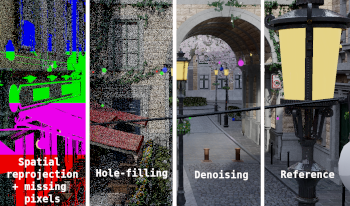
Spatial reprojection can be utilized to lower the computational complexity of stereoscopic path tracing and reach real-time requirements. However it adds dependencies in the pipeline. We perform the handling of data dependencies through a task scheduler framework that embeds workload and dependency information at each stage of the pipeline. We propose a novel image-parallel stereoscopic path tracing pipeline, parallelizing the spatial reprojection stage, the hole-filling stage and post-processing algorithms (denoising, tonemapping) to multiple GPUs. Distributing the workload of the spatial reprojection stage to each GPU allows to locally detect the holes in the images, which are caused by non-reprojected pixels. For the spatial reprojection, denoising and hole-filling stages, we have respectively a speedup of ×2.75, ×4.2 and ×2.89 per GPU on animated scenes. Overall, our pipeline shows a speedup of ×2.25 compared to the open source state-of-the-art path tracer Tauray which only parallelizes path tracing.
Erwan Leria, Markku Mäkitalo, Pekka Jääskeläinen, "Real-time Stereoscopic Image-parallel Path Tracing" in Electronic Imaging, 2024, pp 181-1 - 181-6, https://doi.org/10.2352/EI.2024.36.13.ERVR-181
 Find this author on Google Scholar
Find this author on Google Scholar Find this author on PubMed
Find this author on PubMed